Interview conducted March 22, 2011

The recent financial crisis and subsequent recession have launched a thousand theories from economists eager to explain how a relatively small shock in subprime mortgages led to the most severe financial and economic collapse since the Great Depression. With few exceptions, however, these theories have disregarded global factors that fueled the crisis.
The insights of Ricardo Caballero stand in distinct contrast. Backed by years of research on crises in emerging markets, the Chilean scholar’s recent work illuminates how international capital markets with “an insatiable hunger for safe debt instruments” led U.S. financial institutions to create assets that met technical AAA risk standards but were highly sensitive to macroeconomic, systemic stress.
Global markets froze after the subprime implosion caused confusion at first, and then a cascade of panic and withdrawal among investors who previously believed they held safe assets. “Knightian uncertainty,” Caballero explains, in which even the unknowns aren’t known, induces the financial equivalent of cardiac arrest.
Other economists have developed related ideas, of course: global savings gluts, shadow banking panics. But Caballero blends streams of research on international capital flows, debt markets and finance theory into a coherent theory of systemic crisis.
This leads to policy tools that others overlook. While not dismissing moral hazard concerns, higher capital reserves or better regulatory oversight, Caballero contends that the most effective way to manage (and even prevent) massive financial uncertainty is aggregate insurance provided by government itself. Policy measures taken to date, he suggests, have not remedied the fundamental fragility of the world’s unappeased demand for safe assets.
As chair of one of the world’s leading economics departments, Caballero is also a critical observer of his own field. He’s concerned that macroeconomists today are reluctant to admit that their models ignore empirical realities, that they too often embrace the beauty of theory rather than dealing with hard truths that don’t fit the dominant paradigm.
In professional journals, books and op-eds, and in the following interview, Caballero lays out a provocative and engaging case for a broader, more powerful approach to macroeconomic research and policy.
Assets Scarcity and Financial Crisis
Region: I’d like to focus initially on the financial crisis. You’ve written that the heart of the crisis wasn’t so much lax monetary policy or a faulty regulatory regime, but rather global asset scarcity, which led to the United States holding a “toxic waste” of highly risky assets—a great phrase. It’s an intriguing idea, somewhat novel to me. Could you explain briefly what you mean?
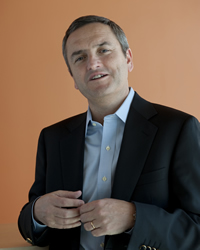
Ricardo Caballero: It’s a story in two steps. The first, present at least since the Asian crisis, is that the world has experienced a shortage of assets to store value. Emerging and commodity-producing economies have added an enormous demand for assets that is not being met by their limited ability to produce these assets. I believe this global asset shortage is one of the main forces behind the so-called global imbalances, the low equilibrium real interest rates that preceded the crisis, and the recurrent emergence of bubbles. Contrary to the conventional wisdom, I think these phenomena are not the result of loose monetary policy, but rather the other way around: Monetary policy is loose because an asset shortage environment would otherwise trigger strong deflationary forces.
This idea is related to Ben Bernanke’s savings glut story;1 he was working on these things at the same time but from a different angle, emphasizing the behavior of savers rather than that of asset supply. The models I developed with Emmanuel Farhi and Pierre-Olivier Gourinchas clarified these different mechanisms.2
Region:You wrote that the entire world had “an insatiable demand for safe debt instruments.”
Caballero: This is the second step, which began in earnest after the Nasdaq crash, when foreign demand for U.S. assets went back to its historical pattern of being heavily concentrated on fixed income (as illustrated by Gourinchas and Rey in their classic paper on the transformation of the United States into a global “venture capitalist”)3 and especially on highly rated instruments. This is the point, together with the natural fragility that emerges from such bias, that I made with Arvind Krishnamurthy at one of the AEA [American Economic Association] meetings.4
The enormous demand for U.S. assets, with a heavy bias toward “AAA” instruments, could not be satisfied by U.S. Treasuries and single-name corporate bonds, and that imbalance generated huge incentives for the U.S. financial system to produce more “AAA” assets.
As a result, we saw both the good and the bad sides of the most dynamic financial system in the world, in full force. Subprime loans became inputs into financial vehicles, which by the law of large numbersA probability theorem describing the result of performing the same experiment many times. The average of results from a number of trials will become closer to the expected value as more trials are performed. and by the principles of tranchingDividing into portions, usually by level of risk. were able to create "AAA" instrumentsA financial instrument with the highest credit rating given by debt agencies such as Standard & Poors and Moody’s. from those that were not.
Region:You mean “seemingly” AAA assets, right? Many contend that rating agencies were too soft in their ratings of these senior tranches.
Caballero: Even if they were, that was not the main problem. A rating of AAA only means that the probability of default of that instrument is sufficiently low to meet this high standard, but it doesn’t say when that instrument will default. Unfortunately, by construction, AAA tranches generated from lower-quality assets are fragile with respect to macroeconomic and systemic shocks, when the law of large numbers doesn’t work. That is, this way of creating safe assets may be able to create micro-AAA assets but not macro-AAA assets. In other words, these assets were not very resilient to macroeconomic shocks, even though they might have technically met AAA risk standards.
In principle, this was not a big issue, but it became a huge one when highly leveraged systemically important institutions began to keep these macro-fragile instruments in their balance sheets (directly, or indirectly through special-purpose vehicles, or SPVsLegal entities established for narrow and often temporary objectives related to regulation, taxation or risk. SPVs are set up by a sponsoring firm specifically to achieve those objectives. An SPV is not an operating company in the usual sense, but rather a “robot” company—a set of rules without employees or a physical location.). This was an accident waiting to happen; AIG and the investment banks should have known better, but the low capital charges were too hard to resist.
Region: So you do favor higher capital requirementsA bank regulation setting specific levels and types of capital to be held in reserve by the bank rather than invested or loaned to others. ?
Caballero: I don’t believe that increasing capital requirements for banks across the board is the right reaction to the crisis itself, but I do think that capital charges for systemically fragile instruments should be very high. From a systemic point of view, it is not the same for a bank to hold a single-name AAA corporate bond as a piece from a collateralized debt obligation’s AAA tranche. The latter is much riskier for the system.
Uncertainty Versus Risk
Region: In several papers, you emphasize the difference between Knightian uncertaintyAfter economist Frank Knight, who distinguished between risk and uncertainty in his 1921 book, Risk, Uncertainty, and Profit. and risk, and describe a policy in which financial institutions would purchase aggregate insurance from the government to deal with uncertainty.
Could you explain this distinction between uncertainty and risk, and elaborate on the idea of aggregate insurance?
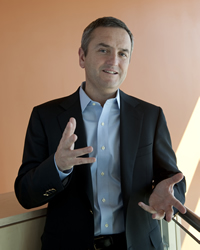
Caballero: Well, in a very different context, Donald Rumsfeld made this distinction very clear for us all when he talked about the difference between known unknowns and unknown unknowns. The former is risk; the latter is uncertainty. Risk has a more or less well-defined set of outcomes and probabilities associated with them. Uncertainty does not—things are much less clear.
Financial institutions (and human beings in general) behave very differently when they don’t understand the risks involved than when they do. In the latter case—straightforward risk—they can adjust their portfolios marginally to accommodate any change in risk profiles.
But with uncertainty, when institutions or people don’t truly understand what the risks are, they know or feel something is wrong but don’t know what and how likely it is, or how it will impact them. In this context, the natural instinct is simply to withdraw rather than to fine-tune. Such abrupt behavior can wreak havoc in a financial system since, all of a sudden, the maturity transformation—the vital role financial systems provide in converting short-term liabilities into long-term assets—has to be undone. But this simply can’t be done when everybody wants to do it at the same time—bank runs are an obvious example of this impossibility—and that further fuels the uncertainty, leading to more panic and fire sales. The financial system is very good at managing risk, but it is awful at handling (Knightian) uncertainty.
Region: It seems that unknown unknowns are happening frequently these days. What can be done to reduce their cost?
Caballero: Obviously, it starts by requiring banks to have solid buffers to manage deep recessions and even extreme idiosyncratic events. But it would be too costly to have the financial system hoard capital sufficient to deal with the panic component of crises. Neither banks individually nor the financial system as a whole should be required to be prepared—in terms of capital reserves—for another Lehman/AIG-like event. That would require freezing an enormous amount of capital. It would be very wasteful.
There is a point in a panic when the government has to say: “Just hold on. Ninety percent of the problem is now the panic. It’s not a real phenomenon, so if we just get rid of the panic, we’re done.”
Region: Like Roosevelt’s “The only thing we have to fear is fear itself.”
Caballero: Exactly. But, of course, just saying this won’t do much; it needs to be backed up by a commitment to support the system, and there are always real things to fix as well.
There are several proposals out there to reduce the cost of the buffer by having capital be “contingent”—that is, having capital available not at all times but only when events justify it. This is a step in the right direction, and the right thing to do for idiosyncratic shocks or normal recessions.
But contingent capital isn’t an adequate tool for fighting the kind of panics that arise from Knightian uncertainty. It’s still too expensive as a mechanism for dealing with that level of panic. For such situations, the system doesn’t need capital but rather insurance or a guarantee that the system will survive. Anxiety is reduced by cutting off the tail of the distribution of possible outcomes, which is poorly understood and frightening, and mostly made of self-fulfilling scenarios.
The advantage of a cheaper arrangement is not that it makes bankers’ lives easier, but that it allows the system to have a much larger weapon against these events. Banks should pay a fee in advance for this insurance, and the fee should be proportional to the systemic risk of their balance sheets. Since the fee is much cheaper than the cost of actual capital, they should be required to buy a lot of insurance.
Region: And this aggregate insurance should be provided by government?
Caballero: Yes. It is the most efficient way because only the government has enough credibility not to have to post collateral in advance.
Region: Would this really be less costly overall, for the entire banking system, than higher capital requirements? Doesn’t it imply that the government would put in its own resources, in the event of a systemic crisis?
Caballero: The private sector should be required to provision capital for actual losses caused by bad loans and even normal recessions, but it should not be asked to freeze capital for panic events. These do not require capital but just guarantees against extreme events that are highly unlikely to occur but that economic agents in panic mode are all too willing to imagine and exaggerate. The government is the only agent that does not need to freeze capital to provide credible guarantees.
Of course, credibility is itself a variable. Solid fiscal health of the government is key for this mechanism to work well, and the level of guarantee has to be commensurate with what the government can handle. The recent financial crisis in Ireland has provided clear evidence of the limits of public guarantees. Having said this, it is important to realize that Ireland’s government provided the guarantees after the crisis began, and hence didn’t charge banks for the insurance premium in advance. The structure of these premia is important to provide the right incentives to banks. Still, we shouldn’t be so naïve as to think that the government or banks will be able to fully understand ex ante all the risks generated by their activities.
It is important to insist that government-provided insurance be only for very extreme events. For more normal events, insurance and hedging arrangements should be an entirely private sector business.
By the way, we already have in the lender of last resort a facility of the kind I am advocating. We just need to extend it to, in effect, a “balance sheet insurer of last resort” that would be activated during systemic, not bank-specific, events, so that the implosion in asset prices that follows panics does not destroy the balance sheets of the financial sector.
Moral Hazard
Region: When you talk about the government backing that kind of risk-taking, you’re talking about the potential for moral hazardWhen persons or institutions protected from risk are thereby encouraged to take on more risk than they would if not so protected.. You’ve developed models of financial crises that distinguish between liquidation shocks and uncertainty shocks, and said those types of shocks differ considerably with regard to moral hazard and the consequences of government bailouts. You’ve written, for example, “The moral hazard issue is less important for uncertainty-driven crises.”
Would you elaborate?
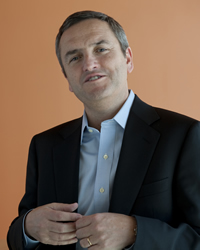
Caballero: Let me first step back a bit and talk about moral hazard. I don’t want to be perceived as someone who totally disregards moral hazard. It is an important phenomenon and a very important element of financial intermediation. There are many, many agency problems within financial intermediaries.
But I think people focus on a kind of moral hazard that it is really secondary, and they do so at the wrong time.
Let me begin with the timing problem. I still recall politicians and economists calling for the need to teach lessons (in a punitive sense) to the financial system in the middle of the crisis. In fact, I think Lehman happened to a large extent due to the political pressures stemming from this view. What timing! The systemic problem of moral hazard is that people take too much risk relative to what is socially optimal. But during a crisis—especially one that is triggered by uncertainty and panic—the problem is exactly the opposite: People are taking too little risk. That’s what flight to quality is all about. The most effective policies at that point are those that induce people to reload on risk.
I wrote many op-eds at all stages of the crisis trying to remind policymakers that punishing institutions, and trying to provide long-term lessons in the middle of the crisis, was likely to add fuel to the uncertainty fire.5 Unfortunately, people need to see in order to believe—a very costly attitude during crises that are inherently very nonlinear phenomena.
Region: You’ve made an analogy, I believe, that providing such lessons is like teaching people to eat right when they’re in the middle of cardiac arrest.
Caballero: Yes, exactly. In my “Sudden Financial Arrest” paper, I draw an analogy between panics and sudden cardiac arrest.6 We all understand that it’s very important to have a good diet and good exercise in order to prevent cardiac arrest. But once you’re in a seizure, that’s a totally secondary issue. You’re not going to solve the crisis by improving the diet of the patient. You don’t have time for that. You need a financial defibrillator, not a lecture.
Region: And you’ve also suggested, haven’t you, that people focus on a secondary type of moral hazard?
Caballero: Yes. There are many incentive problems within the financial system, and hence there is a strong need for regulation. However, it’s ludicrous to suggest that anticipation of support (a “bailout”) in an extreme systemic event is one of the most significant sources of moral hazard.
With very few exceptions—perhaps Fannie Mae and Freddie Mac?—financial institutions and investors (when in bullish mode) make portfolio decisions that are driven by dreams of exorbitant returns, not by distant marginal subsidies built into financial defibrillators. Nothing is further from these investors’ minds than the possibility of (financial) death, and hence they could not ascribe meaningful value to an aid that, in their mind, is meant for someone else.
Logical coherence dictates that if one believes in the undervaluation of the possibility of a future crisis that characterizes the booms that precede crises, then one must also believe in the near-irrelevance of anticipated subsidies during distress for private actions during the boom.
Region: So there is a logical contradiction to the idea of moral hazard driving risk-taking behavior?
Caballero: Yes. And it also comes from the wrong diagnosis.
The main dogma behind the great resistance in the policy world to institutionalize a public insurance provision is the idea that if the financial defibrillator were to be implanted in an economy, banks and their creditors would abandon all forms of a healthy financial lifestyle and would thus dramatically increase the chances of a sudden financial arrest episode.
This moral hazard perspective is the equivalent of discouraging the placement of defibrillators in public places out of concern that, upon seeing them, people would have a sudden urge to consume cheeseburgers because they would realize that their chances of surviving sudden cardiac arrest had risen as a result of the ready access to defibrillators.
But actual behavior is less forward-looking and rational than is implied by that logic. People indeed consume more cheeseburgers than they should, but this is more or less independent of whether or not defibrillators are visible. Surely there is a need for advocating healthy habits, but no one in their right mind would propose doing so by making all available defibrillators inaccessible. Such a policy would be both ineffective as an incentive mechanism and a human tragedy when an episode of sudden cardiac arrest occurs.
I think this is one of the many instances when economists and politicians choose to solve a second-order problem they understand rather than focusing on what actually happens in real life.
Region: But then it seems you’re giving a break to the bankers, by not providing tangible—that is to say, financially punitive—lessons about the danger of their excessive risk-taking.
Caballero: If you think that calling them shortsighted and irrational is giving them a break, then I guess I’m doing that [laughter] ...
By the way, CEOs, equity owners and even debt holders of banks go through miserable times during these crises, as do politicians and countries that are eventually “bailed out” by the IMF [International Monetary Fund]. So the idea that they did what they did because they anticipated the bailout is really strange, to say the least.
I am not defending their investment decisions. I agree that they were the wrong ones. But the reason they made these decisions was not their anticipation of a bailout. So why pay the enormous cost of not having a good antipanic mechanism in place if its absence is not a significant source of better behavior?
Fire Sales and Complexity
Region: Would you tell us about your recent work with Alp Simsek on fire sales, complexity and externalitiesIndirect effects of a consumption or production activity on agents other than the originator of such activity not reflected in prices.?7
Caballero: I think that the essence of many of our problems in macroeconomics as a field stems from the assumption that we, as researchers and policymakers, and the economic agents we model understand things much, much better than is actually the case.
The economy is an incredibly complex object—and I mean “complex” in the sense of very hard to understand. This complexity is not something we can just get rid of in the process of writing simple models, for it is central to economic behavior during crises. My work with Alp is an attempt to capture a small part of this complexity problem and its role during financial crises.
The basic idea is that the economy is a very complicated network of connections, but most of the time economic agents can go about their daily activities without worrying about those complications. To succeed, you—or financial institutions in our model—just need to be good at understanding your local environment.
However, as crises cross a certain threshold, all of a sudden it is no longer enough to understand the local environment. You begin to worry about indirect hits through the network. So what was a relatively simple optimization problem quickly becomes an immensely complex one. At that point, we have moved from a world of more or less well-defined risks to one of (Knightian) uncertainty and, as we discussed earlier, decision makers then become ultraconservative. And the most attractive individual decision is simply to withdraw.
Region: Which triggers a fire sale?
Caballero: Indeed, fire sales are a central aspect of crises. However, one of the points we make in that paper is that if financial markets are sufficiently liquid (in a precise sense that we define in the paper), it is very, very hard to start a fire sale. There are always enough asset buyers to absorb and bid for the assets of the distressed financial institutions.
This changes, however, when we cross the complexity threshold I mentioned earlier. At that point, all potential buyers become concerned with being hit by an indirect shock, so they opt for hoarding their liquidity rather than bidding for the now discounted assets of the distressed institutions. Naturally, this leads to all sorts of perverse feedback effects.
Region: Fire sales involve externalities. But your mechanism also incorporates a separate externality, true?
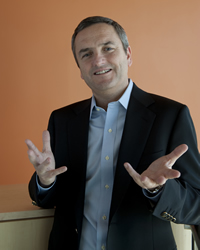
Caballero: Yes, we have the standard fire sale externalities, but we have an additional and novel source of externality, a complexity externality. The main physical contagion mechanism in our model is through network cascades. These network cascades get compounded many times by the behavioral reaction of financial institutions to the increase in complexity of the problem they need to solve once the cascades become sufficiently long. Not only do they have to worry about their neighbor’s financial condition, and the financial condition of the neighbors of their neighbor, but, increasingly, about the financial situations of the neighbors of the neighbors of their neighbor. A tremendously complex cascade!
So any action that lengthens the cascade size—say, for example, a bank’s decision not to use its liquidity to purchase distressed assets—has the potential to generate powerful externalities once the system is near the critical complexity threshold.
Region: Policy was not an explicit focus of that paper, but you do mention a number of policy alternatives: bailouts, liquidity provisions, stress testing. Would you discuss some of those? Also, economists sometimes propose that externalities be taxed. Is there any role for taxation?
Caballero: Yes, there’s a role, although they come in mixtures. For example, a bailout of distressed institutions funded by small lump-sum taxes on all the banks may lead to Pareto improvements. Without such a policy, our model’s equilibrium fails to replicate this redistribution—that is, the financial system won’t provide this solution if left to its own devices—because each bank fails to internalize that its contribution to a bailout will reduce payoff uncertainty of all banks. My sense is that the many efforts by Treasury and the Fed during the crisis to find and “persuade” the main banks to buy distressed assets were of this kind.
But also, once the system is in the fire sales equilibrium, policies that support asset prices become very effective by coordinating agents closer to a fair-price equilibrium. Many of the most successful policies implemented during the crisis were of this kind—for example, the support for the commercial paper market and the backup liquidity facility for money markets. Unfortunately, the political process often delayed these policies to a point where much of the damage had already been done.
Region: You advocated the latter kind of policy in your 2008 paper with Arvind Krishnamurthy,8 and then in Jackson Hole in your 2009 paper with Pablo Kurlat.9
Caballero: Yes. I began to work on Knightian uncertainty and its policy conclusion with Arvind well before the crisis. We argued that a lender-of-last-resort facility would be particularly effective in dealing with panics of this kind even if the policymaker is less informed than the private banks about the allocation of distress. When we first wrote that paper, not many people noticed it, but then the crisis came and we ended up getting the Smith Breeden Prize for it [laughter].
With Pablo, I proposed an automatic mechanism to deal with panics in which banks would be required to buy ex ante a sort of contingent credit default swap (CDS) A type of insurance that protects the lender if the borrower defaults. If the loan defaults, its liability becomes a credit for payment from the CDS issuer.contract for their systemically risky assets. That is, they would pay in advance for having the right to have their assets guaranteed in the event of a systemic (not an idiosyncratic) crisis. As I said earlier, the political process doesn’t have the right speed to deal with a panic-driven crisis. We need to be prepared in advance. That’s where the idea of a financial defibrillator comes into play.
Relation to Other Research
Region: How do you view your work in relation to research by others? Gary Gorton’s work on shadow banking panics, for instance.10 Princeton’s Markus Brunnermeier’s research also comes to mind;11 as well as the work of Adrian and Shin at the New York Fed,12 and the NYU-Stern Business School folks13 —these economists and others have been studying financial crises, with a focus on this past one.
Would you describe how your ideas are similar to, or distinct from, theirs in terms of shocks, transmission mechanisms and policy?
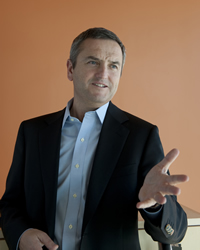
Caballero: All the names you mention have done important work in this area, and most of them have made multiple contributions, so it is difficult to summarize. The main common element is the emphasis on the endogenous and perverse feedbacks that arise when asset fire sales take place. We all talk about amplification mechanisms, linkages gone wrong, and the connection and feedback between volatility and the tightness of financial constraints.
Perhaps the closest in interpretation of the nature of the events and the structural factors behind the conditions that led to the panic is the work of Gary Gorton. He highlights the role of collateral in the repo market and how this structural feature can naturally lead to runs. This is an aspect of the AAA asset demand I’ve been talking about, although I have highlighted more the role of sovereign investors than that of the repo market. Also, his work with Bengt Holmström pointing out the importance of the information-insensitiveness of debt contracts for the functioning of repo markets, and how all hell breaks loose once debt becomes information-sensitive, resembles the complexity threshold mechanism of my work with Alp.
Relative to most economists, Gary and I tend—for severe systemic events—to place blame less on incentive failures and more on accidents that arise from the very nature of what financial intermediaries do. As such, it is not surprising that our policy emphasis is on how to prevent and deal with these accidents rather than—or not as much—on how to constrain the financial system so it doesn’t misbehave.
Similarly, I share with Gary the view that most of the regulatory changes that we hear about are really not addressing the fundamental problem: There was and still is a very large demand for collateral and AAA assets which markets are not able to satisfy. Who knows what kind of substitute the private sector will come up with? And, even worse, what kind of fragilities will emerge from the fact that policymakers have not focused their energy on helping to shape this solution but instead chose to fight the wars of the past?
Lessons from Emerging Markets
Region: I’d like to ask you about your earlier work on emerging markets, especially some of your research on sudden stops A sudden slowdown or reversal in a country’s capital inflows.and sterilizationAny form of monetary policy undertaken to maintain domestic money supply in the face of international capital flows. Often done to minimize currency appreciation and inflation due to such transfers. efforts. What lessons can we learn about dealing with recessions or the recent financial crisis from the experience of emerging markets and their crises? What lessons are or are not pertinent?
Caballero: I think the main distinction is that for emerging markets and most economies around the world, there is a big difference between domestic and foreign funding. There is a domestic and an international liquidity. Most of my work with Arvind is about this distinction and how the largest crises are the result of shortages of international liquidity that arise during the so-called sudden stops. Consequently, my work on contingent arrangements for emerging markets, primarily with Stavros Panageas, is about optimal insurance arrangements against these sudden stops.14
In contrast, for the United States, the distinction between domestic and international liquidity doesn’t make much sense, and thus the current account itself is not a primary concern. I think this view was vindicated during the crisis, which had the United States as the epicenter, but the dollar appreciated during the worst of it!
Having said this, there is an analogy within the United States itself. The crisis was a sudden stop to its private financial system—not from foreigners, but from all investors. Not surprisingly, some of the contingent insurance arrangements that apply to sovereigns also apply to the U.S. financial system.
The other analogy is that external capital flows concentrated in particular kinds of instruments did strain the U.S. financial system and expose its regulatory weaknesses. A much less sophisticated version of this (in the sense that it doesn’t include complex financial instruments and innovation) is also common in the financial system of emerging markets when they are flooded by capital flows.
Region: So in the recent crisis, there was a shortage, but of a different kind: not too little international liquidity, but a scarcity of safe assets.
Caballero: In a sense, yes. The global scarcity of safe assets is what created pressure and distorted the incentives of the U.S. financial system. The analogy is that investors suddenly discovered that the safe assets the financial system was selling weren’t macro-safe. In that sense, it was a shortage of macro-safe assets that behaved like a shortage of international liquidity.
However, there was another key scarcity during the crisis: a political shortage. The subprime crisis was minute relative to the wealth of the United States, but that’s irrelevant during a crisis when the political system becomes an obstacle to the much-needed reallocation. I completely underestimated how significant a constraint the political process could be. It was very much like that faced at the aggregate level by emerging markets when there is a shortage of international liquidity.
The Role of the IMF
Region: In 2003, you wrote an article about “The Future of the IMF,” and you suggested that the International Monetary Fund should do more to support emerging markets when they’re under stress—before they enter full-blown cardiac arrest—by helping to develop hedging and insurance instruments, collateralized debt obligations (CDOs)A type of security whose value and payments derive from a portfolio of fixed-income assets; in this case, those assets would be contingent bonds. of contingent bonds.15 This sounds very much like your proposal about aggregate insurance sold by the government. Could you elaborate on your contingent bond idea?
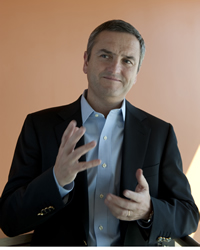
Caballero: First, I should clarify that I didn’t choose that title. It was an American Economic Association session with a predetermined title. I never felt comfortable with it, so I redefined the IMF acronym in the first paragraph to mean International Market Facilitator. The IMF does many things; I just wanted to focus on the much narrower goal of facilitating private capital deployment to emerging markets during crises.
In that context, I thought the IMF could play a dual role in supporting private sector facilities designed to sell insurance to these countries. As an example, I imagined that countries could sell contingent debt instruments to a (mostly) privately funded CDO. The IMF would play a prequalification role by determining which countries could sell contingent debt to the CDOs, and it would also put its money where its mouth is by investing in a junior tranche of the CDO.
Come to think of it, this arrangement is not too different from the facilities that the Europeans and IMF have created recently to help the euro zone’s periphery economies—Greece, Ireland and Portugal, in particular—during the ongoing turmoil.
Region: Has the IMF taken any steps in that direction vis-à-vis emerging markets? And have your thoughts about the role and relevance of the IMF or other international financial institutions changed since 2003, particularly in light of the financial crisis?
Caballero: Yes, definitely. The IMF has been refining and significantly enlarging its contingent facilities. However, I don’t think they are leveraging their resources much by involving the private sector. They need to engage in joint ventures, not only with governments but also with the private sector.
The lesson of the current crisis for these arrangements is that since these would be systemically fragile instruments, we don’t want the highly leveraged players to be holding the tranches without significant capital charges.
Recessions and Restructuring
Region: Some of your research in the past has suggested that restructuring after recessions is slower than many economists believe, and you’ve looked at some of the obstacles to restructuring, from labor market rigidities to zombie lending. You emphasize the importance of policies that enable creative destruction to function more swiftly, to restore microeconomic flexibility and better macro performance.
What do you see as current rigidities, either internationally or for specific nations—the United States or in Europe, for instance—that are likely to impede recovery from the recent recession?
And should we be concerned about jobless recovery in the United States? Do you think there might now be a higher level of structural unemployment?
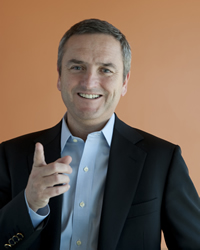
Caballero: That’s the gist of my work with Mohamad Hammour from the 1990s.16 This was a time when the important work of Steve Davis and John Haltiwanger in documenting the nature of the process of job creation and destruction in U.S. manufacturing led to an explosion of research trying to explain this process.
One of the key features of their findings was that recessions come with sharp spikes in job destruction. Somehow, other researchers jumped to the conclusion that this spike meant that job reallocation was strongly countercyclical. That is, that reallocation increased during recessions: a sort of Schumpeterian cleansing. Many theories were written about this phenomenon.
Mohamad and I made the rather obvious observation that a spike in destruction in itself does not mean that reallocation increases during recessions, since this would also require that creation increases. Steve and John had already documented that job creation actually falls at impact. We explored whether the initial spike in destruction translated into abnormally high creation during the recovery phase of the cycle, which would be a dynamic version of the countercyclical reallocation story. Not only did we not find this increase in creation during the recovery, but we found that job creation was actually below normal levels. That is, cumulative restructuring is procyclical, not countercyclical.
We then went on to show that a model where financial constraints tighten as a result of the recession could explain such patterns. I think this is the connection with the current recovery. This was a recession which severely damaged the financial sector; hence, it is not surprising that hiring is so muted.
Of course, we need to add to this that we still have a recession in the residential construction sector, which will keep unemployment high for quite some time.
You also mention my work on Japanese zombies with Anil Kashyap and Takeo Hoshi.17 There we documented a chronic version of the above phenomenon. We showed how weak domestic banks have depressed much-needed restructuring in post-bubble Japan.
The Pretense-of-Knowledge Syndrome
Region: At the end of last year, you published a rather biting critique of the way both academic and central bank researchers practice macroeconomics.18 You warned that what you called the “pretense-of-knowledge syndrome” is dangerous for both methodological and policy reasons.
Would you briefly review that critique and elaborate on what you consider a silver lining—that by seeking tools and policies that are robust to the “enormous uncertainty to which we are confined,” we can make some progress? Also, would you tell us how your colleagues have responded to your critique?
Caballero: There is an enormous selection bias in the reactions. I’ve mostly heard the positive ones, which have been plenty, but I’m sure I didn’t please everyone—there are many polite people in our profession [laughter].
Region: It occurs to me that as head of the department at MIT, you have real influence in terms of how economics is taught here. Does it shape the way you teach and where you lead the department?

Caballero: Well, the assumption that a department head has that kind of power is quite a stretch [laughter]! Having said this, I’m about to teach a course in which I will, in the introduction, talk briefly about this methodological issue. But I still need to teach the basic models. That won’t change.
In fact, I think it is very important to clarify that I am not antimodel. On the contrary, the economy is so complex that there is little hope of understanding much without models. I just don’t want these models to acquire a life that is independent from the purpose they are ultimately designed to serve, which is to understand the functioning of real economies.
The critique part of the paper you refer to argued that the current core of macroeconomics has become so mesmerized with its own internal logic that it begins to confuse the precision it has achieved about its own world with the precision it has about the real one.
There is absolutely nothing wrong with building stylized structures as just one more tool to understand a piece of the complex problem. My problems with this start when these structures take on a life on their own, and researchers choose to “take the model seriously”—a statement that signals the time to leave a seminar, for it is always followed by a sequence of naïve and surreal claims.
The quantitative implications of this core approach, which are built on supposedly “micro-founded” calibrations of key parameters, are definitely on the surreal side. Take, for example, the preferred “micro-foundation” of the supply of capital in the workhorse models of the core approach. A key parameter to calibrate in these models is the intertemporal substitution elasticity of a representative agent, which is to be estimated from micro-data. A whole literature develops around this estimation, which narrows the parameter to certain values, which are then to be used and honored by anyone wanting to say something about “modern” macroeconomics.
This parameter may be a reasonable estimate for an individual agent facing a specific micro decision, but what does it have to do with the aggregate? What happened with the role of Chinese bureaucrats, Gulf autocrats and the like in the supply of capital? A typical answer is not to worry about it, because this is all “as if.” But then, why do we call this strategy “micro-foundation” rather than “reduced-form”?
My point is that by some strange herding process, the core of macroeconomics seems to transform things that may have been useful modeling short-cuts into a part of a new and artificial “reality.” And now suddenly everyone uses the same language, which in the next iteration gets confused with, and eventually replaces, reality. Along the way, this process of make-believe substitution raises our presumption of knowledge about the workings of a complex economy and increases the risks of a “pretense of knowledge” about which Hayek warned us in his Nobel Prize acceptance speech.
Region: We mistake the model for truth itself.
Caballero: Yes. It is much more convenient to talk about things we understand than about things we are struggling to understand. But at the end of the day, we’re supposed to explain the things that are hard to understand, so we are spinning the wheels to help us feel busy rather than making actual progress.
Region: What should be done to improve this state of affairs?
Caballero: I argue in the paper that there are lots of useful insights being produced in the periphery of macroeconomics, and that perhaps a key step is to embrace the complexity of the environment and what it does to economic agents and their decisions, as well as to our conclusions as researchers. I think the work on robust control by Hansen, Sargent and others is a step in the right direction, although it still assumes that policymakers know too much.
But a big part of my point is that no one really knows with any certainty what we need to do next, and hence we need to allow for much more freedom of exploration. We shouldn’t specialize so much in one particular class of models because we’re not sufficiently close to an absolute truth to do that. That’s the optimal thing to do when you’re very close to the global maximum, which we are not. We should be a lot more tolerant of alternative approaches and never forget our mission, which is to help understand an overwhelmingly complex reality, not to replace it with one that is more convenient to us as researchers.
Region: Thank you very much.
March 22, 2011
More About RICARDO J. CABALLERO
Current Positions
Chair, Department of Economics, Massachusetts Institute of Technology, since 2008; Ford International Professor of Economics, since 2000; Co-director, World Economic Laboratory, since 2003; on MIT faculty since 1992
Previous Positions
Associate Professor of Economics, Columbia University, 1990–92; Assistant Professor, 1988–90
Visiting Scholar and Consultant: European Central Bank, Federal Reserve Board of Governors, Inter-American Development Bank, International Monetary Fund, World Bank and other central banks and government institutions around the world on multiple occasions
Affiliations and Activities
Member, National Academy of Sciences Board on Mathematical Sciences and Their Applications, since 2009
Associate Editor, Open-Assessment E-Journal, since 2006; Cuadernos de Economía, since 1995; Revista de Análisis Económico, since 1992
Member, Editorial Board, MIT Press, since 2005-08; Journal of Restructuring Finance, since 2003; Central Banking, Analysis and Economic Policy Series, Central Bank of Chile
Member, International Scientific Committee, Revista di Politica Economica, since 2003
International Research Fellow, Kiel Institute of World Economics, since 2001
Member, Advisory Group, Brookings Panel on Economic Activity, since 1999
Member, Scientific Advisory Board, Centre de Recerca en Economica Internacional, Barcelona, since 1999
Research Associate, National Bureau of Economic Research, since 1994; NBER Faculty Fellow, 1991–94; NBER Olin Fellow, 1991–92
Research Fellow, Alfred P. Sloan Foundation, 1991–95
Honors and Awards
Fellow, American Academy of Arts and Sciences, since 2010
Emerald Management Review Citation of Excellence Award, 2008
Smith Breeden First Prize for Best Paper, Journal of Finance, 2008
Frisch Medal, Econometric Society, 2002
Chile's Economist of the Year, El Mercurio (Chilean newspaper), 2001
Fellow, Econometric Society, since 1998
Publications
Prolific author of journal articles, books, chapters, popular articles and op-eds on macroeconomics, international economics and finance. Current research on global capital markets, financial bubbles, crisis prevention and dynamic restructuring. Policy work on aggregate risk management for emerging markets and developed economies.
Education
Massachusetts Institute of Technology, Ph.D. in economics, 1988
Pontificia Universidad Católica de Chile, M.A. in economics, 1983
Pontificia Universidad Católica de Chile, B.S. in economics, 1982
Endnotes
1 Bernanke, Ben S. 2005. “The Global Saving Glut and the U.S. Current Account Deficit.” Remarks at the Sandridge Lecture, Virginia Association of Economists, Richmond, Va., March 10.
2 Caballero, Ricardo J., Emmanuel Farhi and Pierre-Olivier Gourinchas. 2008. “An Equilibrium Model of ‘Global Imbalances’ and Low Interest Rates.” American Economic Review 98 (1), 358-93.
3 Gourinchas, Pierre-Olivier, and Hélène Rey. 2007. “From World Banker to World Venture Capitalist: U.S. External Adjustment and the Exorbitant Privilege.” In Current Account Imbalances: Sustainability and Adjustment. Richard H. Clarida, ed. University of Chicago Press, 11-66.
4 Caballero, Ricardo J., and Arvind Krishnamurthy. 2009. “Global Imbalances and Financial Fragility.”American Economic Review 99 (2), 584-88.
5 See articles listed at http://econ-www.mit.edu/faculty/caball/light.
6 Caballero, Ricardo, J. 2009. “Sudden Financial Arrest.” Paper presented at the 10th Jacques Polak Annual Research Conference, International Monetary Fund, Washington, D.C., Nov. 5-6.
7 Caballero, Ricardo J., and Alp Simsek. 2011. “Fire Sales in a Model of Complexity.”
8 Caballero, Ricardo J., and Arvind Krishnamurthy. 2008. “Collective Risk management in a Flight to Quality Episode.” Journal of Finance 63 (5), 2195-2230.
9 Caballero, Ricardo J., and Pablo D. Kurlat. 2009. “The ‘Surprising’ Origin and Nature of Financial Crises: A Macroeconomic Proposal.” MIT Department of Economics Working Paper 09-24.
10 Interview. The Region. December 2010. Federal Reserve Bank of Minneapolis.
11 Go to http://www.princeton.edu/~markus/.
12 See, for example, Federal Reserve Bank of New York Staff Reports 346 and 382.
13 Go to http://whitepapers.stern.nyu.edu/home.html.
14 See, for example, NBER Working Papers 10786 and 11293.
15 Caballero, Ricardo J. 2003. “The Future of the IMF.” American Economic Review 93 (2), 31-38.
16 Caballero, Ricardo J., and Mohamad L. Hammour. 2005. “The Cost of Recessions Revisited: A Reverse-Liquidationist View.” Review of Economic Studies 72, 313-41.
Caballero, Ricardo J., and Mohamad L. Hammour. 1999. “Institutions, Restructuring, and Macroeconomic Performance.” Invited lecture, 12th World Congress of the International Economic Association, Buenos Aires, Argentina, August 25.
Caballero, Ricardo J., and Mohamad L. Hammour. 1998. “Jobless Growth: Appropriability, Factor Substitution and Unemployment.” Carnegie-Rochester Conference Series on Public Policy 48 (June), 51-94.
Caballero, Ricardo J., and Mohamad L. Hammour. 1996. “On the Ills of Adjustment.” Journal of Development Economics 51, 161-92.
Caballero, Ricardo J., and Mohamad L. Hammour. 1996. “On the Timing and Efficiency of Creative Destruction.” Quarterly Journal of Economics 446 (3), 805-52.
17 Caballero, Ricardo J., Takeo Hoshi and Anil K. Kashyap. 2008. “Zombie Lending and Depressed Restructuring in Japan.” American Economic Review 98 (5), 1943-77.
18 Caballero, Ricardo J. 2010. “Macroeconomics after the Crisis: Time to Deal with the Pretense-of-Knowledge Syndrome.” MIT Department of Economics Working Paper 10-16.





